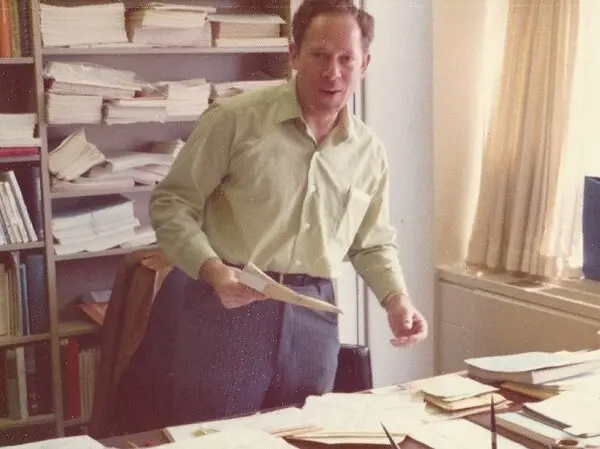This is Einstein at Princeton, 1935.
He was tasked to find which young physicists would revolutionize science.
His unconventional method found Oppenheimer, Wheeler, and Nobel-Prize winners before anyone knew their names.
Here is his ONE method to spotting genius: 🧵
He was tasked to find which young physicists would revolutionize science.
His unconventional method found Oppenheimer, Wheeler, and Nobel-Prize winners before anyone knew their names.
Here is his ONE method to spotting genius: 🧵

In 1933, Einstein arrived at Princeton's Institute for Advanced Study.
His first task? Build a team of young physicists who could help advance his unified field theory.
But his method of choosing collaborators left everyone shocked:

His first task? Build a team of young physicists who could help advance his unified field theory.
But his method of choosing collaborators left everyone shocked:


Einstein's office at Princeton was simple:
Just a desk, chalkboard, and an unusual collection of "failed" physics papers.
These weren't just any papers - they were intentionally wrong solutions to famous physics problems.
He used them to test every candidate who walked through his door.

Just a desk, chalkboard, and an unusual collection of "failed" physics papers.
These weren't just any papers - they were intentionally wrong solutions to famous physics problems.
He used them to test every candidate who walked through his door.


His process was unconventional:
1. Give the candidate a known physics problem
2. Let them solve it
3. Show them the "wrong" solution
4. Watch their reaction
What he looked for wasn't knowledge - it was something far more valuable...
1. Give the candidate a known physics problem
2. Let them solve it
3. Show them the "wrong" solution
4. Watch their reaction
What he looked for wasn't knowledge - it was something far more valuable...

Most candidates would immediately point out the errors.
"This violates the conservation of energy!"
"The mathematics here is incorrect!"
Einstein would thank them politely and never call them back.
But some candidates had a very different reaction...
"This violates the conservation of energy!"
"The mathematics here is incorrect!"
Einstein would thank them politely and never call them back.
But some candidates had a very different reaction...

These special few would stare at the wrong solution, fascinated.
"This is impossible... but what if it wasn't?"
"If this were true, it would mean..."
They'd spend hours exploring the implications of the "mistake."
"This is impossible... but what if it wasn't?"
"If this were true, it would mean..."
They'd spend hours exploring the implications of the "mistake."
This was Einstein's real test:
Not whether someone could spot errors, but whether they could see the hidden possibilities within "wrong" ideas.
He called it "productive confusion" - the ability to let go of established rules and explore new territories.
Not whether someone could spot errors, but whether they could see the hidden possibilities within "wrong" ideas.
He called it "productive confusion" - the ability to let go of established rules and explore new territories.

One of his first picks was John Wheeler in 1939.
Instead of dismissing an incorrect quantum mechanics solution, Wheeler spent 3 hours exploring its implications.
Wheeler later pioneered blac
k hole physics and quantum information theory - concepts that seemed "wrong" to everyone else.
Instead of dismissing an incorrect quantum mechanics solution, Wheeler spent 3 hours exploring its implications.
Wheeler later pioneered blac
k hole physics and quantum information theory - concepts that seemed "wrong" to everyone else.

Robert Oppenheimer was another who passed Einstein's unusual test.
When shown a "flawed" solution about particle physics, he said: "This breaks every rule we know... but it's beautiful."
Oppenheimer later led the Manhattan Project and revolutionized quantum field theory.
When shown a "flawed" solution about particle physics, he said: "This breaks every rule we know... but it's beautiful."
Oppenheimer later led the Manhattan Project and revolutionized quantum field theory.

Einstein's method wasn't about finding people who were "right."
It was about finding people who could see beauty in being wrong - who could explore impossible ideas until they became possible.
This is the cornerstone of theoretical physics.
It was about finding people who could see beauty in being wrong - who could explore impossible ideas until they became possible.
This is the cornerstone of theoretical physics.
His chosen collaborators went on to:
• Discover black holes
• Pioneer nuclear physics
• Create information theory
• Develop quantum field theory
All because they weren't afraid to explore "wrong" ideas.
• Discover black holes
• Pioneer nuclear physics
• Create information theory
• Develop quantum field theory
All because they weren't afraid to explore "wrong" ideas.
Einstein's philosophy was simple:
"If at first an idea doesn't seem absurd, there's no hope for it."
He believed true breakthroughs come from those willing to question everything - even what seems obviously "correct."
"If at first an idea doesn't seem absurd, there's no hope for it."
He believed true breakthroughs come from those willing to question everything - even what seems obviously "correct."
His talent identification method reveals a deeper meaning:
Innovation doesn't come from knowing all the right answers.
It comes from being willing to explore the wrong ones.
James Gleick shares the common character traits of geniuses:
Innovation doesn't come from knowing all the right answers.
It comes from being willing to explore the wrong ones.
James Gleick shares the common character traits of geniuses:
Want more fascinating stories about great minds and their unconventional methods?
Follow @LearningToan for weekly threads about the forgotten stories of genius thinkers throughout history.
What's your ONE biggest takeaway from this thread?
Follow @LearningToan for weekly threads about the forgotten stories of genius thinkers throughout history.
What's your ONE biggest takeaway from this thread?
If you want to write threads like this, subscribe to my free 5-day email course to learn about the 5 common mistakes creators make when writing viral threads.
writeviralthread.com
writeviralthread.com
• • •
Missing some Tweet in this thread? You can try to
force a refresh






















